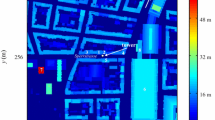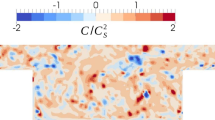Abstract
Lagrangian and Eulerian statistics are obtained from a water-channel experiment of an idealized two-dimensional urban canopy flow in neutral conditions. The objective is to quantify the Eulerian \((T^{\mathrm{E}})\) and Lagrangian \((T^{\mathrm{L}})\) time scales of the turbulence above the canopy layer as well as to investigate their dependence on the aspect ratio of the canopy, AR, as the latter is the ratio of the width (W) to the height (H) of the canyon. Experiments are also conducted for the case of flat terrain, which can be thought of as equivalent to a classical one-directional shear flow. The values found for the Eulerian time scales on flat terrain are in agreement with previous numerical results found in the literature. It is found that both the streamwise and vertical components of the Lagrangian time scale, \(T_\mathrm{u}^\mathrm{L} \) and \(T_\mathrm{w}^\mathrm{L} \), follow Raupach’s linear law within the constant-flux layer. The same holds true for \(T_\mathrm{w}^\mathrm{L} \) in both the canopies analyzed \((AR= 1\) and \(AR= 2\)) and also for \(T_\mathrm{u}^\mathrm{L} \) when \(AR = 1\). In contrast, for \(AR = 2\), \(T_\mathrm{u}^\mathrm{L} \) follows Raupach’s law only above \(z=2H\). Below that level, \(T_\mathrm{u}^\mathrm{L} \) is nearly constant with height, showing at \(z=H\) a value approximately one order of magnitude greater than that found for \(AR = 1\). It is shown that the assumption usually adopted for flat terrain, that \(\beta =T^{\mathrm{L}}/T^{\mathrm{E}}\) is proportional to the inverse of the turbulence intensity, also holds true even for the canopy flow in the constant-flux layer. In particular, \(\gamma /i_\mathrm{u} \) fits well \(\beta _\mathrm{u} =T_\mathrm{u}^\mathrm{L} /T_\mathrm{u}^\mathrm{E} \) in both the configurations by choosing \(\gamma \) to be 0.35 (here, \(i_\mathrm{u} =\sigma _\mathrm{u} / \bar{u} \), where \(\bar{u} \) and \(\sigma _\mathrm{u} \) are the mean and the root-mean-square of the streamwise velocity component, respectively). On the other hand, \(\beta _\mathrm{w} =T_\mathrm{w}^\mathrm{L} /T_\mathrm{w}^\mathrm{E} \) follows approximately \(\gamma /i_\mathrm{w} =0.65/\left( {\sigma _\mathrm{w} /\bar{u} } \right) \) for \(z > 2H\), irrespective of the AR value. The second main objective is to estimate other parameters of interest in dispersion studies, such as the eddy diffusivity of momentum \((K_\mathrm{{T}})\) and the Kolmogorov constant \((C_0)\). It is found that \(C_0\) depends appreciably on the velocity component both for the flat terrain and canopy flow, even though for the latter case it is insensitive to AR values. In all the three experimental configurations analyzed here, \(K_\mathrm{{T}}\) shows an overall linear growth with height in agreement with the linear trend predicted by Prandtl’s theory.
















Similar content being viewed by others
References
Amicarelli A, Salizzoni P, Leuzzi G, Monti P, Soulhac L, Cierco F-X, Leboeuf F (2012) Sensitivity analysis of a concentration fluctuation model to dissipation rate estimates. Int J Environ Pollut 48:164–173
Anfossi D, Rizza U, Mangia C, Degrazia GA, Pereira Marques Filho E (2006) Estimation of the ratio between the Lagrangian and Eulerian time scales in an atmospheric boundary layer generated by large eddy simulation. Atmos Environ 40:326–337
Badas MG, Ferrari S, Garau M, Querzoli G (2017) On the effect of gable roof on natural ventilation in two-dimensional urban canyons. J Wind Eng Ind Aerodyn 162:24–34
Bai K, Katz J, Meneveau C (2015) Turbulent flow structure inside a canopy with complex multi-scale elements. Boundary-Layer Meteorol 155:435–457
Baik J-J, Park R-S, Chun H-Y, Kim J-J (2000) A laboratory model of urban street canyon flows. J Appl Meteorol 39:1592–1600
Barlow JF (2014) Progress in observing and modelling the urban boundary layer. Urban Clim 10:216–240
Barlow JF, Coceal O (2009) A review of urban roughness sublayer turbulence. UK Met Office Technical Report No. 527, p 68
Barlow JF, Harman IN, Belcher SE (2004) Scalar fluxes from urban street canyons. Part I: laboratory simulation. Boundary-Layer Meteorol 113:369–385
Boffetta G, Cencini M, Espa S, Querzoli G (2000) Chaotic advection and relative dispersion in an experimental convective flow. Phys Fluids 12:3160–3167
Castro IP, Cheng H, Reynolds R (2006) Turbulence over urban-type roughness: deductions from wind-tunnel measurements. Boundary-Layer Meteorol 118:109–131
Cenedese A, Del Prete Z, Miozzi M, Querzoli G (2005) A laboratory investigation of the flow in the left ventricle of a human heart with prosthetic, tilting-disk valves. Exp Fluids 39:322–335
Coceal O, Dobre A, Thomas TG, Belcher SE (2007) Structure of turbulent flow over regular arrays of cubical roughness. J Fluid Mech 589:375–409
Corrsin S (1963) Estimates of the relations between Eulerian and Lagrangian scales in large Reynolds number turbulence. J Atmos Sci 20:115–119
Dallman A, Di Sabatino S, Fernando HJS (2013) Flow and turbulence in an industrial/suburban roughness canopy. Environ Fluid Mech 13:279–307
Di Bernardino A, Monti P, Leuzzi G, Querzoli G (2015a) On the effect of the aspect ratio on flow and turbulence over a two-dimensional street canyon. Int J Environ Pollut 58:27–38
Di Bernardino A, Monti P, Leuzzi G, Querzoli G (2015b) Water-channel study of flow and turbulence past a two-dimensional array of obstacles. Boundary-Layer Meteorol 155:73–85
Finnigan J (2000) Turbulence in plant canopies. Annu Rev Fluid Mech 32:519–571
Flesch TK, Wilson JD (1992) A two-dimensional trajectory-simulation model for non-Gaussian, inhomogeneous turbulence within plant canopies. Boundary-Layer Meteorol 61:349–374
Grimmond CSB, Oke TR (1999) Aerodynamic properties of urban areas derived from analysis of urban surface form. J Appl Meteorol 38:1261–1292
Guala M, Liberzon A, Tsinober A, Kinzelbach W (2007) An experimental investigation on Lagrangian correlations of small-scale turbulence at low Reynolds number. J Fluid Mech 574:405–427
Hanna SR (1981) Lagrangian and Eulerian time-scale in the daytime boundary layer. J Appl Meteorol 20:242–249
Haverd V, Leuning R, Griffith D, van Gorsel E, Cuntz M (2009) The turbulent Lagrangian time scale in forest canopies constrained by fluxes, concentrations and source distributions. Boundary-Layer Meteorol 130:209–228
Hinze J (1975) Turbulence. McGraw-Hill, New York
Iliopoulos I, Hanratty TJ (1999) Turbulent dispersion in a non-homogeneous field. J Fluid Mech 392:45–71
Kastner-Klein P, Rotach MW (2004) Mean flow and turbulence characteristics in an urban roughness sublayer. Boundary-Layer Meteorol 111:55–84
Leonardi S, Orlandi P, Djenidi L, Antonia RA (2004) Structure of turbulent channel flow with square bars on one wall. Int J Heat Fluid Flow 25:384–392
Leonardi S, Orlandi P, Djenidi L, Antonia RA (2015) Heat transfer in a turbulent channel flow with square bars or circular rods on one wall. J Fluid Mech 776:512–530
Leuning R, Denmead OT, Miyata A, Kim J (2000) Source/sink distributions of heat, water vapour, carbon dioxide and methane in a rice canopy estimated using Lagrangian dispersion analysis. Agric For Meteorol 104:233–249
Leuzzi G, Amicarelli A, Monti P, Thomson DJ (2012) A 3D Lagrangian micromixing dispersion model LAGFLUM and its validation with a wind tunnel experiment. Atmos Environ 54:117–126
Li PY, Taylor PA (2005) Three-dimensional Lagrangian simulation of suspended particles in the neutrally stratified atmospheric surface layer. Boundary-Layer Meteorol 116:301–311
Lien RC, D’Asaro EA (2002) The Kolmogorov constant for the Lagrangian velocity spectrum and structure function. Phys Fluids 14:4456–4459
Luhar AK, Britter RE (1989) A random walk model for dispersion in inhomogeneous turbulence in a convective boundary layer. Atmos Environ 23:1911–1924
Luo J, Ushijima T, Kitoh O, Lu Z, Liu Y (2007) Lagrangian dispersion in turbulent channel flow and its relationship to Eulerian statistics. Int J Heat Fluid Flow 28:871–881
Michioka T, Sato A, Takimoto H, Kanda M (2011) Large-eddy simulation for the mechanism of pollutant removal from a two-dimensional street canyon. Boundary-Layer Meteorol 138:195–213
Mito Y, Hanratty TJ (2002) Use of a modified Langevin equation to describe turbulent dispersion of fluid particles in a channel flow. Flow Turbul Combust 68:1–26
Mölder M, Klemedtsson L, Lindroth A (2004) Turbulence characteristics and dispersion in a forest–tests of Thomson’s random-flight model. Agric For Meteorol 127:203–222
Monin AS, Yaglom AM (1975) Statistical fluid mechanics, vol 2. The MIT Press, Cambridge
Monti P, Leuzzi G (1996) A closure to derive a three-dimensional well-mixed trajectory model for non-Gaussian, inhomogeneous turbulence. Boundary-Layer Meteorol 80:311–331
Monti P, Leuzzi G (2010) Lagrangian models of dispersion in marine environment. Environ Fluid Mech 10:637–656
Monti P, Querzoli G, Cenedese A, Piccinini S (2007) Mixing properties of a stably stratified parallel shear layer. Phys Fluids 19:085104. doi:10.1063/1.2756580
Neophytou MK-A, Markides CN, Fokaides PA (2014) An experimental study of the flow through and over two-dimensional rectangular roughness elements: Deductions for urban boundary layer parameterizations and exchange processes. Phys Fluids 26:086603
Oke T (1987) Boundary-layer climates. Routledge, London
Ouellette NT, Xu H, Bourgoin M, Bodenschatz E (2006) Small-scale anisotropy in Lagrangian turbulence. New J Phys 8:102
Panofsky HA, Dutton JA (1984) Atmospheric turbulence. Wiley, New York
Pasquill F (1974) Atmospheric diffusion. Wiley, New York
Pelliccioni A, Monti P, Leuzzi G (2016) Wind-speed profile and roughness sublayer depth modelling in urban boundary layers. Boundary-Layer Meteorol 160:225–248
Poggi D, Katul G, Albertson J (2006) Scalar dispersion within a model canopy: measurements and three-dimensional Lagrangian models. Adv Water Resour 29:326–335
Poggi D, Katul GG, Cassiani M (2008) On the anomalous behavior of the Lagrangian structure function similarity constant inside dense canopies. Atmos Environ 42:4212–4231
Raupach MR (1989) Applying Lagrangian fluid mechanics to infer scalar source distributions from concentration profiles in plant canopies. Agric For Meteorol 47:85–108
Raupach MR, Shaw RH (1982) Averaging procedures for flow within vegetation canopies. Boundary-Layer Meteorol 22:79–90
Reynolds RT, Castro IP (2008) Measurements in an urban-type boundary layer. Exp Fluids 45:141–156
Rotach MW (1999) On the influence of the urban roughness sublayer on turbulence and dispersion. Atmos Environ 33:4001–4008
Salizzoni P, Marro M, Soulhac L, Grosjean N, Perkins RJ (2011) Turbulent transfer between street canyons and the overlying atmospheric boundary layer. Boundary-Layer Meteorol 141:393–414
Sawford BL (2001) Turbulent relative dispersion. Annu Rev Fluid Mech 33:289–317
Snyder WH (1972) Similarity criteria for the application of fluid models to the study of air pollution meteorology. Boundary-Layer Meteorol 3:113–134
Stocchino A, Besio G, Angiolani S, Brocchini M (2011) Lagrangian mixing in straight compound channels. J Fluid Mech 675:168–198
Stull RB (1988) An introduction to boundary layer meteorology. Kluwer, Dordrecht
Takimoto H, Sato A, Barlow JF, Moriwaki R, Inagaki A, Onomura S, Kanda M (2011) Particle image velocimetry measurements of turbulent flow in outdoor and indoor urban scale models and flushing motions in urban canopy layers. Boundary-Layer Meteorol 140:295–314
Taylor GI (1921) Diffusion by continuous movements. Proc Lond Math Soc 20:196
Thomson DJ (1987) Criteria for the selection of stochastic models of particle trajectories in turbulent flows. J Fluid Mech 180:529–556
Uehara K, Wakamatsu S, Ooka R (2003) Studies on critical Reynolds number indices for wind-tunnel experiments on flow within urban areas. Boundary-Layer Meteorol 107:353–370
VDI (2000) Physical modelling of flow and dispersion processes in the atmospheric boundary layer application of wind tunnels. Verein Deutcher Ingenieure (VDI), Berlin
Wallace JM, Vukoslavčević PV (2010) Measurement of the velocity gradient tensor in turbulent flows. Annu Rev Fluid Mech 42:157–181
Wang QZ, Squires KD, Wu X (1995) Lagrangian statistics in turbulent channel flows. Atmos Environ 29:2417–2427
Wilczek M, Xu H, Narita Y (2014) A note on Taylor’s hypothesis under large-scale flow variation. Nonlin Processes Geophys 21:645–649
Wilson JD, Sawford BL (1996) Review of Lagrangian stochastic models for trajectories in the turbulent atmosphere. Boundary-Layer Meteorol 78:191–210
Yeung PK (2002) Lagrangian investigations of turbulence. Annu Rev Fluid Mech 34:115–142
Author information
Authors and Affiliations
Corresponding author
Rights and permissions
About this article
Cite this article
Di Bernardino, A., Monti, P., Leuzzi, G. et al. Water-Channel Estimation of Eulerian and Lagrangian Time Scales of the Turbulence in Idealized Two-Dimensional Urban Canopies. Boundary-Layer Meteorol 165, 251–276 (2017). https://doi.org/10.1007/s10546-017-0278-6
Received:
Accepted:
Published:
Issue Date:
DOI: https://doi.org/10.1007/s10546-017-0278-6




